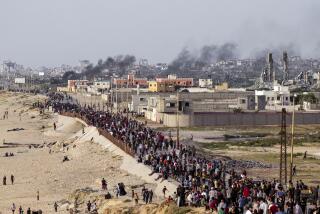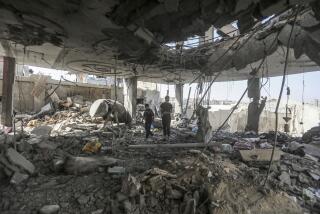U.S. Plans a Parallel Regime
- Share via
WASHINGTON — The Pentagon hopes to topple the Iraqi leadership without a full-scale invasion of Baghdad by seizing the nation’s key levers of power and installing a new interim government even before Saddam Hussein’s regime has been deposed, military and administration officials said Thursday.
The goal of the plan is to isolate Hussein’s regime and make it “irrelevant” to the Iraqi people even if the Iraqi president or other key members of his government remain holed up in the capital.
The strategy is attractive to Pentagon planners because it offers an alternative to heavy urban fighting, which many expect would result in large numbers of casualties and significant destruction of the city.
Portions of the plan were suggested Thursday by Air Force Gen. Richard B. Myers, chairman of the Joint Chiefs of Staff, and details were spelled out by other government officials.
In a briefing at the Pentagon, Myers suggested that American forces could systematically choke off Hussein’s regime rather than lay siege to the capital city. He described a scenario in which U.S. forces would take control of basic government institutions and services, such as the water supply, the power grid and the communications infrastructure.
The remnants of Hussein’s government “would not be in charge of anything except their own defense,” Myers said. At that point, he said, “whatever is happening in Baghdad is almost irrelevant compared to what’s going on in the rest of the country.”
The strategy hinges on U.S. forces’ ability to secure large swaths of the country, capture critical pieces of infrastructure and quickly win the support of Iraqis even before they have seen conclusive evidence of Hussein’s demise.
Ongoing fighting in cities in southern Iraq suggests that these objectives may not be easy to attain in Baghdad, where Hussein is said to have massed his most loyal fighters.
Declaring an interim government before the war ends or Hussein is ousted would be a policy shift and could attract opposition from the State Department and elsewhere in the Bush administration.
The interim government envisioned by Pentagon planners would be set up either outside Baghdad or in sectors of the city the United States controls. One possibility is to establish the new government at Saddam International Airport, which U.S. troops seized Thursday.
Myers and other officials said the aim would be to establish an Iraqi administration as early as possible, although officials indicated that there is no timetable in place.
One Pentagon official likened the plan to moving into a house before the previous occupants have finished moving out.
“Just leave the furniture where it is,” the official said.
Myers and Defense Secretary Donald H. Rumsfeld stressed that the war is entering a difficult stage. Neither ruled out alternative military scenarios, including an all-out invasion of Baghdad.
But Myers noted several factors working in the U.S.-led forces’ favor. He said about half of the 5 million people living in Baghdad are Shiite Muslims who have been oppressed by Hussein’s regime.
“You could assume they might be helpful” to U.S. forces, he said.
He also said that U.S. forces already control the southern oil fields, which account for a large portion of Iraq’s economic resources.
The tactic calls for some U.S. troops to dig into their positions on the outskirts of Baghdad while other airborne units take control of swaths of territory in the city by helicoptering into parks and other public spaces and securing areas piecemeal, taking control of critical services.
The strategy, if successful, would force senior leaders of the Iraqi regime deep into hiding in a smaller and smaller area while U.S. forces rush humanitarian aid and support of all kinds to the people in the city and the rest of the country.
“We have the rat trapped,” said retired Army Maj. Gen. Edward Atkeson, former deputy chief of staff for intelligence, of this scenario. “If you isolate the government structure in this society that is truly controlled from the top down, then what you have is a country without a government. They don’t have another structure to fall back on. We keep some forces in to surround him and we just pound and pound him, and meanwhile we go ahead with reconstruction. He’s cut off, trapped, what’s the rush?”
Myers suggested that time would be on the side of U.S. forces in the scenario he outlined.
“One of the things you can do is be patient,” Myers said.
Senior defense officials described the strategy as a middle ground between an all-out assault and a drawn-out siege, in which troops would encircle, blockade and bomb the city.
The insertion of troops could subject them to street battles with fighters loyal to Hussein, sniper fire, suicide attacks and attack by chemical or biological weapons. And the strategy, if it does not work fast enough, runs the risk of leaving a city to languish, fearful and chaotic.
By seizing control of key portions of the city, then gradually convincing civilians that U.S. forces are in charge -- and not Hussein -- commanders hope that Iraqis would provide intelligence on where command centers, arms caches and senior leadership are.
Eventually, U.S. forces would need to act on that information and root out Hussein and his lieutenants, if they are still alive.
“In the end, while they are still in that city in large numbers they are still going to be the biggest, baddest people on the block, at least in the minds of the people who live in Baghdad, until we go in and crush them,” said Michael O’Hanlon, a military expert at the Brookings Institution, a nonpartisan Washington think tank.
The U.S. military approach to Baghdad, it appears, will have more in common with the careful, cautious planning that went into the rescue of Army Pfc. Jessica Lynch than with the pell-mell urban assault that some had envisioned.
“The battle for Baghdad will be slow and methodical, and it should be,” said retired Army Maj. Gen. William Nash, a former commander of U.S. forces in Bosnia-Herzegovina and an armored brigade commander in the 1991 Persian Gulf War. “If we turn Saddam into the besieged mayor of Baghdad, so be it for now. By using intelligence in the service of a slow, methodical process by which we use armor, infantry, special operations forces and precision firepower, we can continue to bite away at that elephant that is Baghdad.”
It is a strategy that will rely on intelligence on the state of Iraqi defenses of the city. And it will rely, Myers said, on being patient.
“You’re going to have Baghdad isolated, you’re going to have half the population that probably wants nothing to do with the folks -- the oppressive regime. And then you’ll start working at it as you can,” Myers said.
Administration officials have outlined plans for a U.S. team headed by retired Gen. Jay M. Garner to initially take over administration of Iraq.
The aim would be for Garner’s team to quickly hand over authority of civilian ministries to members of an Iraqi “educated elite” and some Iraqi exiles, but also tribal leaders, Kurds, Shiites and Sunni intellectuals who remained in Iraq through Hussein’s decades of dictatorship.
During that transition, Garner would serve as Iraq’s interim civil administrator, and a host of U.S. State, Treasury and Commerce Department officials would occupy key positions throughout the country.
But the exact makeup of this interim governing group remains unclear, and there is sharp disagreement between the Defense and State departments on several points.
*
Times staff writers Mark Fineman, Robin Wright and John Hendren contributed to this report.
More to Read
Sign up for Essential California
The most important California stories and recommendations in your inbox every morning.
You may occasionally receive promotional content from the Los Angeles Times.










